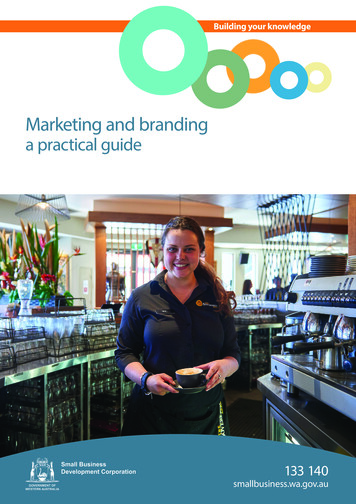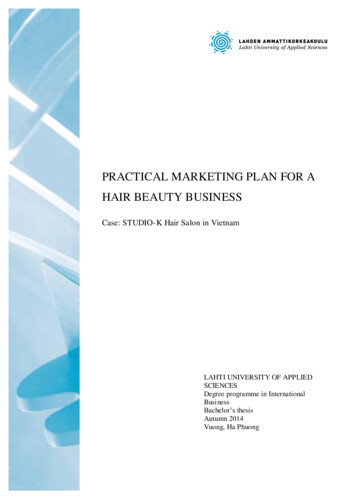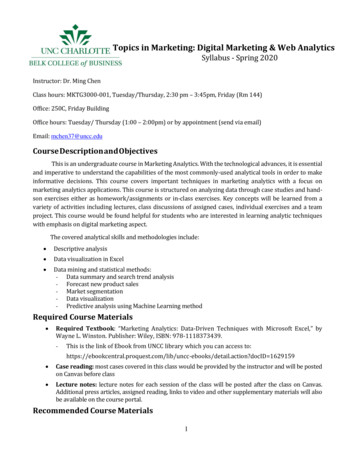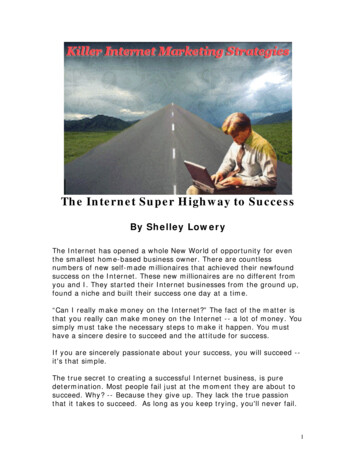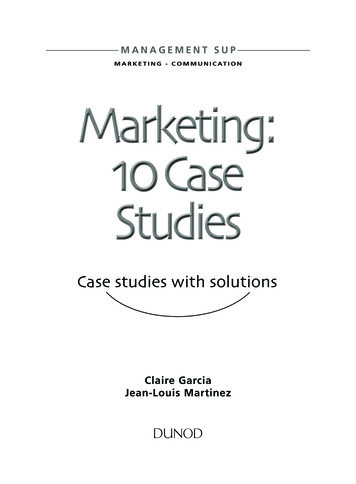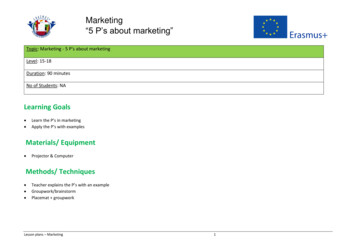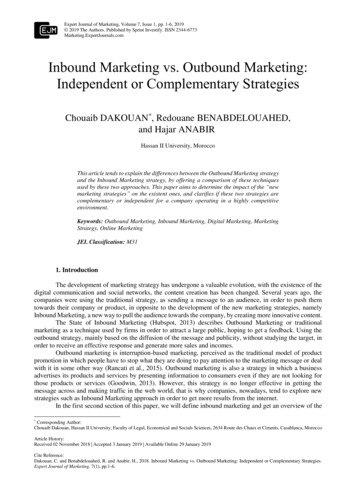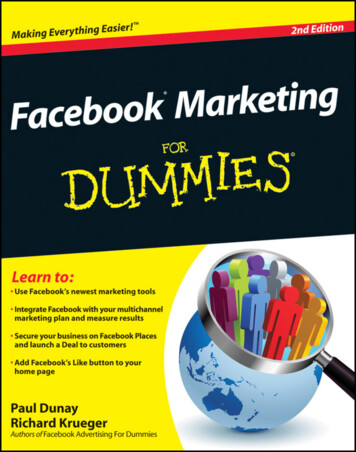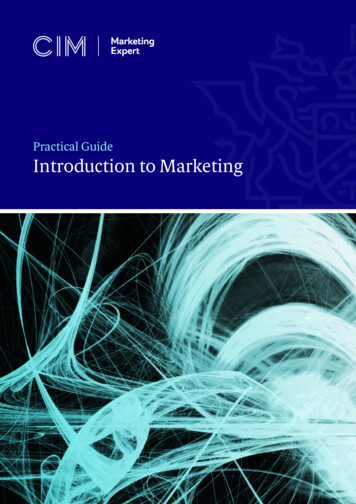
Transcription
Practical GuideIntroduction to MarketingINTRODUCTION TO MARKETING 1
“Marketing is themanagement processresponsible foridentifying, anticipatingand satisfying customerrequirements profitably.”What is marketing?Every product we buy, every store we visit, every mediamessage we receive and every choice we make in ourconsumer society has been shaped by the forces of marketing.CIM (The Chartered Institute of Marketing) offersthe following definition for marketing: “The managementprocess responsible for identifying, anticipating andsatisfying customer requirements profitably.”Sometimes people assume marketing is just aboutadvertising or selling, but this is not the whole story. It isa key management discipline that ensures producers ofgoods and services can interpret consumer desires andmatch, or exceed them.The marketing process is central to the businessperformance of companies, both large and small, becauseit addresses the most important aspects of the market. Itis about understanding the competitive marketplace andensuring you can tap into key trends, reaching consumerswith the right product at the right price, place and time.Clever marketing has led to many recent business successstories - from pharmaceuticals to airlines, sports brandsto food and drink, business-to-business companiesto small, niche players.Conversely, history reminds us that without propermarketing, you can’t get close to customers and satisfytheir needs – and if you can’t, a competitor surely will.Getting close has become more important than everas digital and mobile technology make inroads into allaspects of life. This revolution has also provided new toolsto make marketing more targeted, relevant and effective.Today, as competitive pressures increase, marketing skillshave never been more highly valued. What was once seenas a departmental activity is now regarded as a frontlinebusiness attitude for all employees.The professionals who shape and implement marketingstrategy contribute directly to the economy. Their skillsattract and retain customers, build sales and increaseprofits – generating wealth for all.2 CIM MARKETING EXPERT – PRACTICAL GUIDE
Why marketing?You might not be advertising your services, but youprobably do make an effort to know your customerswell. Your instincts tell you that figuring out whatevery customer wants, and meeting those expectations,will keep you in business. You know that you need toimprove and extend existing products, and sometimesdevelop new ones.More recently, two further ‘P’s were added –Process and Physical evidence. Originally formulatedfor the service industry, they are just as importantin other sectors.But is this kind of ‘unconscious’ marketing adequate?In the 1990s, as experts realised that business hadto become more customer-centric, an alternative‘4 Cs’ of marketing was proposed. Correlatingalmost directly with the original 4PS, they were:Customer, Cost, Convenience and Communication.The 7Ps model, however, has endured and morethan adequately incorporates today’s customer-firstmarketing world.If you don’t understand that you’re ‘doing’ marketing,it’s hard to keep things consistent over time. Thisisn’t an obvious problem for very small organisations,but marketing on the hoof becomes less feasible asyou grow.The professionals who shape and implementmarketing strategy contribute directly to theeconomy. Their skills attract and retain customers,build sales and increase profits – generating wealthfor all.If this description rings true, your marketing activityclosely fits the classic definition used by CIM.How do you create a proper marketing strategy for thefuture? How can you keep up with your competitors,exploiting all the latest technological developmentsat a time of rapid change?Applying a simple marketing framework is vital. Itenables you to plan your activities in advance, findout what works, then use them again when andwhere they are most effective.The rest of this article will help you to do just that,giving you suggestions for practical marketing thatbuilds on what you are already doing.It deals with what a company is going to produce,how much it is going to charge, how it is going todeliver products or services to the customer, andhow it is going to tell its customers about itsproducts and services.Traditionally, these considerations were knownas the 4Ps – Product, Price, Place and Promotion.As marketing became a more sophisticated discipline,a fifth ‘P’ was added – People.INTRODUCTION TO MARKETING 3
P1ProductThere is no point in developing a product or servicethat no one wants to buy, yet many businesses decidewhat to offer first, then hope to find a market forit afterwards.Successful companies find out what customers needor want and then develop the right product with theright level of quality to meet their expectations, bothnow and in the future. A product does not have to be tangible– an insurance policy can be a product The perfect product provides value for thecustomer. This value is in the eye of the beholder– we must give our customers what they want,not what we think they want Ask yourself whether you have a system in placeto regularly check what your customers think ofyour product and your supporting services Find out what their needs are now and whetherthey believe these will change in future Beware the product quality trap – don’t take ittoo far by trying to sell a Rolls-Royce when thecustomer really wants a Nissan Micra4 CIM MARKETING EXPERT – PRACTICAL GUIDEP2PriceA product is only worth what customers are preparedto pay for it. The price needs to be competitive, butthis doesn’t mean you have to be the cheapest in yourmarket – small businesses can compete with largerrivals by offering a more personal service, value-addsor better value for money.You also need to make a profit. Pricing is the onlyelement of the marketing mix that generates revenue– everything else represents a cost to you.When considering the price of your product, it’simportant to look at it from the customer’s perspective: Price positions you in the marketplace it tells customers where to place you in relationto your competitors The more you charge, the more value or qualityyour customers will expect for their money. This is a relative measure. If you are the mostexpensive provider in your market, customerswill expect you to provide a better service Everything that the customer sees must beconsistent with these higher quality expectations– packaging, environment, promotional materials,website, letterheads, invoices, etc Existing customers are generally less sensitiveabout price than new customers – a good reasonto look after them well.
P3PlaceThe product must be available in the right place,at the right time and in the right quantity, whilekeeping storage, inventory and distribution coststo an acceptable level.The place where customers buy a product, andthe means of distributing your product to that place,must be appropriate and convenient for the customer.This applies to brick-and-mortar operations, but iseven more important in e-commerce. P4PromotionPromotion is the way a company communicates whatit does and what it can offer customers. It includesbranding, advertising, PR, corporate identity, socialmedia outreach, sales management, special offersand exhibitions. Promotion must gain attention, beappealing, send a consistent message and – above all– give the customer a reason to choose your productrather than someone else’s. Customer surveys show that delivery performanceis one of the most important criteria whenchoosing a supplierGood promotion is not one-way communication– it paves the way for a dialogue with customers,whether in person or online Place also means ways of displaying your productto customer groups. This could be in a shopwindow, but it could also be onlinePromotion should communicate the benefitsthat a customer receives from a product, notjust its features Your website is often the customer’s firstexperience of your company – you only have onechance to make a good first impression, so makesure that information on the site is always kept upto date and the design is updated to keep it fresh Explore new channels – from traditional print adsto the latest social media trends, there is now aworld of possibilities to explore. The importantprinciple is to always advertise where your targetconsumer goes Printed promotional material must grab theattention of your customers. It should be easyto read and enable the customer to identify whythey should buy your product A brochure isn’t necessarily the best way ofpromoting your business. Unlike your website,the information is fixed once a brochure has beenprinted. A more cost- effective and flexible optionmight be a folder with a professionally designedsheet inside, over a series of your own informationsheets produced in-house. These sheets can becustomised by varying them to suit the targetcustomers and/or changing them as required Promotion does not just mean communicatingwith your customers. It is just as important tocommunicate with staff/fellow employees aboutthe value and attributes of your products. Theycan then pass on the knowledge to their customersE-commerce operations that sell exclusively onthe internet, must place even more emphasis onthe company website and other online activities,as there are fewer points where the customerwill interact with the companyFor the same reason, all firms that sell onlineshould consider how the product will be deliveredto the consumer – even if this is handled by athird partyMobile is an increasingly important purchasingchannel for consumers, so it may be a good timeto optimise your website. Does yours conform tothe latest standards? For example, Google searchnow penalises websites that are not optimisedfor mobile, potentially making it more difficultfor consumers to find youINTRODUCTION TO MARKETING 5
P5PeopleEveryone who comes into contact with yourcustomers will make an impression. Many customerscannot separate the product or service from thestaff member who provides it, so your peoplewill have a profound effect – positive or negative– on customer satisfaction.–– The reputation of your brand rests in the handsof your staff. They must be appropriately trained,well-motivated and have the right attitude–– All employees who have contact with customersshould be well-suited to the role–– In the age of social media, every employeecan potentially reach a mass audience.–– Formulate a policy for online interactionand make sure everyone stays on-message–– Likewise, happy customers are excellentadvocates for your business. Curate goodopinion on review sites–– Superior after sales support and advice addsvalue to your offering, and can give you acompetitive edge. These services will probablybecome more important than price for manycustomers over time–– Look regularly at the products that accountfor the highest percentage of your sales. Dothese products have adequate after sales support,or are you being complacent with them? Couldyou enhance your support without too muchadditional cost?6 CIM MARKETING EXPERT – PRACTICAL GUIDEP6ProcessMany customers no longer simply buy a productor service - they invest in an entire experience thatstarts from the moment they discover your companyand lasts through to purchase and beyond.–– That means the process of delivering theproduct or service, and the behaviour of thosewho deliver it, are crucial to customer satisfaction.A user-friendly internet experience, waiting times,the information given to customers and thehelpfulness of staff are vital to keepcustomers happy–– Customers are not interested in the detail of howyour business runs, just that the system works.However, they may want reassurance they arebuying from a reputable or ‘authentic’ supplier.–– Remember the value of a good first impression.Identify where most customers initially comeinto contact with your company - whether onlineor offline - and ensure the process there, fromencounter to purchase, is seamless–– Ensure that your systems are designed for thecustomer’s benefit, not the company’s convenience–– Do customers have to wait? Are they keptinformed? Is your website fast enough andavailable on the right devices? Are your peoplehelpful? Is your service efficiently carried out?Do your staff interact in a manner appropriateto your pricing?–– Customers trying to reach your company by phoneare a vital source of income and returning value;but so often they are left on hold. Many will giveup, go elsewhere and tell their friends not to useyour company - just because of the poor process
P7Physical EvidenceChoosing an unfamiliar product or service is riskyfor the consumer, because they don’t know how goodit will be until after purchase. You can reduce thisuncertainty by helping potential customers ‘see’what they are buying.–– A clean, tidy and well-decorated reception area– or homepage - is reassuring. If your digital orphysical premises aren’t up to scratch, whywould the customer think your service is?–– The physical evidence demonstrated by anorganisation must confirm the assumptions ofthe customer — a financial services product willneed to be delivered in a formal setting, whilea children’s birthday entertainment companyshould adopt a more relaxed approach–– Some companies engage customers and askfor their feedback, so that they can developreference materials. New customers can thensee these testimonials and are more likely topurchase with confidence–– Although the customer cannot experience theservice before purchase, he or she can talk toother people with experience of the service. Theirtestimony is credible, because their views do notcome from the company. Alternatively, well-shotvideo testimonials and reviews on independentwebsites will add authenticityEach of the ‘ingredients’ of the marketing mix is keyto success. No element can be considered in isolation– you cannot, for example, develop a product wi
as digital and mobile technology make inroads into all aspects of life. This revolution has also provided new tools to make marketing more targeted, relevant and effective. Today, as competitive pressures increase, marketing skills have never been more highly valued. What was once seen as a departmental activity is now regarded as a frontline business attitude for all employees. The .


